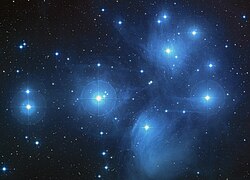Massive star cluster found in Milky Way
Saturday, March 26, 2005

European astronomers discovered a very young and huge star cluster within our Milky Way galaxy using European Southern Observatory telescopes. The discovery was made at the La Silla Observatory in Chile.
Hidden behind a veil of dust and gas, the super star cluster, known as Westerlund 1, is 1000 times closer than any other known clusters. These Super star clusters were previously known to exist as pairs or groups of interacting galaxies located at immense intergalactic distances. It is so close--within 10,000 light years--scientists will be able to examine its structure in detail. Until now, super clusters were far too distant for individual stars to be distinguished.
Initial observations have led scientists to conclude the group contains at least 100,000 times the mass of the Sun, with some single stars shining with a power of 1,000,000 suns and 2000 times larger than our own. All the stars are in a region less than six light years across.
The existence of Westerlund 1's has been known since 1961. Discovered by Swedish astronomer Bengt Westerlund while in Australia, the cluster is located in the Southern constellation Ara (the Altar). It was a dimming factor of more than 100,000 caused by the gas and dust between us and the cluster that prevented the actual structure and nature of the phenomenon to be determined.
Using a variety of instruments, including the Wide Field Imager (WFI) attached to a 2.2 meter scope and the Superb-Seeing Imager 2 (SuSI2) camera on the ESO 3.5 meter New Technology Telescope (NTT), 200 cluster member stars were identified. These and other observations have revealed the cluster contains young stars on the order of 30-40 times more massive than our own Sun. The age range has been determined at 3.5 to five million years old, making this cluster very young compared to the Galaxy itself at around 13.5 billion years.
The research will appear in the leading research journal Astronomy and Astrophysics, and is titled "On the massive stellar population of the Super Star Cluster Westerlund 1", by J.S. Clark and colleagues. A second paper, "Further Wolf-Rayet stars in the starburst cluster Westerlund 1", by Ignacio Negueruela and Simon Clark will also be published in the same journal.
Sources
- "ESO's Telescopes Uncover Super Star Cluster in the Milky Way" — ESO, March 22, 2005